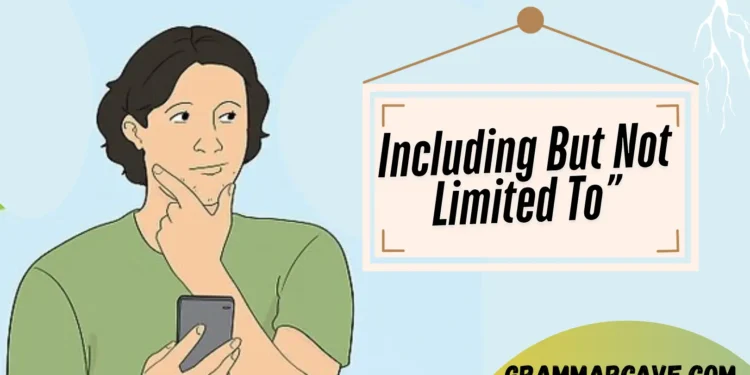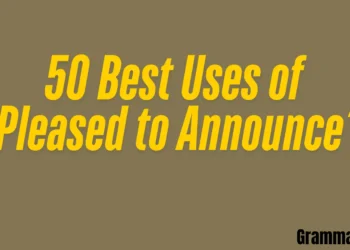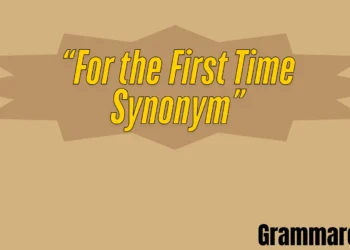Legal, professional, and daily situations frequently use the phrase including but not limited to making clear that the examples given are not complete. Offering specific instances guarantees flexibility and makes it a useful instrument for clear communication.
What Does “Including But Not Limited To” Mean?
This phrase suggests that the listed goods are part of a bigger, non-exhaustive list therefore allowing space for other, unmentioned components. It helps one to escape strict constraints yet keep clarity.
Saying”including but not limited to” is it professional/courtesy
Particularly in formal or legal writing, yes, it is seen as professional and polite as it guarantees accuracy without being too limiting. But in natural conversation, more basic choices such as these would be more sought.Also know about More Grammar Synonym on the Blog.
When should you resist using “including but not limited to”?
Although the phrase is helpful in official or legal papers, it may sound oververbose in creative writing, informal conversations, or short messages. When brevity and legibility are more crucial than legal accuracy, pick for simpler terms such as like, such as, or for example.
Advantages and Disadvantages of including but not limited to
Advantages
1. Legal Certainty: helps to avoid constrained readings in contracts or agreements by making sure a list is not understood to be complete.
2. Professional Tone: Appropriate for official, academic, or business documents, professional tone adds formality and clarity.
3. Flexibility: allows for more, unknown goods without the need to include every possibility.
4. Avoiding miscommunication that instances are just a subset of possibilities helps to prevent misinterpretation.
5. Widely Recognized: Generally accepted in legal and professional settings, lowering the need for more clarification.
Disadvantages
1. Wordiness: Particularly in informal writing, wordiness can make sentences too lengthy and bulky.
2. Overly Formal: This may sound rigid or unnatural in regular talks, emails, or creative writing.
3. Redundancy: Many times, simpler terms such as or for example communicate the same meaning more effectively.
4. Potential Confusion: Less acquainted viewers could see the term as perplexing or too sophisticated.
5. Overuse Risk: Repetitive use of a document can render writing seem repetitious or too legalistic.
Alternatives Including But Not Limited To

1. Such as
Meaning: Introduce examples illustrating the point being made.
Definition: An introduction to a particular category of goods.
Explanation: Common in formal and informal writing, it helps clarify by citing typical examples.
Scenario Example: In this dish, you can employ several fruits including bananas, apples, and oranges.
Best Use: In semi-formal or casual writing where listing a few examples suffices.
Worst Use: In legal agreements needing nonlimitation and specificity.
Tone: Conversational, neutral.
2. For example
Meaning: Presents one or more concrete instances to back up a claim.
Definition: A transitional phrase to give an example of something just mentioned.
Explanation: Commonly used and helpful in both spoken and written communication to clarify an idea.
Scenario Example: “Many cities have excellent public transportation. For example: Tokyo and Berlin.”
Best Use: When highlighting a point in general writing, articles, or essays.
Worst Use: in legal papers needing full inclusiveness.
Tone: Informal to natural.
3. Among others
Meaning: Points to the fact that the list of goods is incomplete.
Definition: A phrase indicating that other comparable goods exist but are nameless.
Explanation: Used after listing one or more items to show more exist.
Scenario Example: Among other things, she excels in marketing, SEO, and branding.
Best Use: It is for demonstrating that the instances belong to a bigger group.
Worst Use: When you need to present a full or precise list.
Tone: Formal and instructive.
4. Including
Meaning: Demonstrating that something is part of a group’s whole.
Definition: Presents illustrations that build on something said.
Explanation: It suggests one component of a set, but depending on circumstances it may or may not be comprehensive.
Scenario Example: “Remote workers as well must attend the meeting.”
Best Use: Formal, professional contexts for clarification of inclusions are ideal.
Worst Use: When it’s not clear if the list is open-ended or complete.
Tone: Usually formal, neither one nor the other.
5. Not limited to
Meaning: Shows that the cited examples or list is not complete.
Definition: Often linked with inclusion to highlight openness, a phrase is called a definition.
Explanation: Often used in legal and official papers to prevent narrowing of scope.
Scenario Example: “You’ll manage a variety of tasks, including but not limited to data entry, client calls, and scheduling.”
Best Use: job descriptions, policies, and contracts.
Worst Use: casual chats or when brevity is preferred.
Tone: Formal, exact.
6. Like
Meaning: Informally presents instances to illustrate a point.
Definition: Used to name representative items.
Explanation: Less formal and more conversational than “such as.”
Scenario Example: “For design purposes, you could utilize programs such Canva or Figma.”
Best Use: In marketing or casual scenarios.
Worst Use: Because of vagueness in formal or legal writing.
Tone: Casual, Conversational.
7. For instance
Meaning: Presents a concrete example meant to show a broad concept.
Definition: Like “for example,” often used in academic or semi-formal situations.
Explanation: Emphasizes clarity by using a real-world example.
Scenario Example: “Some countries, like Norway, provide free university tuition.”
Best Use: Essays, presentations, professional correspondence.
Worst Use: In legalese demanding clear inclusivity.
Tone: Neutral to somewhat formal.
8. Examples include
Meaning: Demonstrates that listed objects are examples from a bigger category.
Definition: Used to introduce illustrative examples.
Explanation: Notes a non-exhaustive list with a focus on actual situations.
Scenario Example: ” JavaScript frameworks React, Angular, and Vue, among others, provide instances.”
Best Use: Introductory examples via academic, commercial, or technical writing.
Worst Use: If attempting to indicate a thorough list.
Tone: Neutral, a little formal.
9. These may include
Meaning: The next items are on a possible, not certain, list.
Definition: Introduces probable instances without guaranteeing all apply.
Explanation: Often used to preserve openness and flexibility in descriptions.
Scenario Example: “Potential risks could include data loss, downtime, and subpar UX.”
Best Use: proposals, risk analyses, flexible business situations.
Worst Use: When particular or guaranteed examples are required.
Tone: careful, adaptable.
10. As an example
Meaning: Provide one example of a more general idea.
Definition: Used to show one particular case or item.
Explanation: Highlights one example to clarify a notion.
Scenario Example: “Airbnb, for instance, upset the hotel sector by means of technology.”
Best Use: narratives, reports, teaching, presentations
Worst Use: Where multiple examples are needed.
Tone: Clear, explanatory.
11. Including a few of
Meaning: Offers a few cases from a larger group.
Definition: This shows that the objects specified make only part of the whole set.
Explanation: Used to introduce a few significant or prominent examples without claiming to list all.
Scenario Example: “The work entails many duties, including some marketing, research, and content generation.”
Best Use: In informal or conversational writing when you want to highlight select examples.
Worst Use: Legal or formal situations needing more exact or all-encompassing wording.
Tone: Casual, selective.
12. To name a few
Meaning: Signals indicate that the specified things are only a small number from a bigger collection.
Definition: A remark stressing the incompleteness of a list.
Explanation: Usually employed following instances to demonstrate more could be said.
Scenario Example: “He has worked in numerous cities: London, Dubai, and New York, to mention only a few.”
Best Use: In casual writing or speech to bypass lengthy lists.
Worst Use: In legal papers or academic documents requiring perfect clarity and completeness.
Tone: Casual, conversationally toned.
13. Like the following
Meaning: Gets the reader ready for a particular collection of illustrations.
Definition: Presents a list reflecting what was lately covered.
Explanation: The following are representative examples.
Scenario Example: “You’ll need tools like a hammer, screwdriver, and pliers.”
Best Use: instructional content, guides, or lists.
Worst Use: In very official or legal writing where like may be unclear.
Tone: Neutral.
14. Commonly involving
Meaning: Offers commonplace or frequent elements inside a category or procedure.
Definition: Describes often but not promised inclusions.
Explanation: It presents classic elements devoid of confirmation of their ongoing existence.
Scenario Example: Often, the position requires customer service and administrative duties.
Best Use: Description in which generalizing is tolerable.
Worst Use: In legal or technical situations where clarity is required.
Tone: neutral, overall.
15. Often includes
Meaning: Shows repeating but not certain elements.
Definition: Indicates that something is usually—though not always—part of the subject.
Explanation: Usable for outlining patterns or trends.
Scenario Example: “Our process sometimes involves customer input and repeated changes.”
Best Use: Noncontractual papers, reports, or project descriptions.
Worst Use: in legally binding wording calling certainty.
Tone: casual to neutral.
16. Involving such things as
Meaning: Presents a category with varied and adaptable illustrations.
Definition: Presents several categories of goods belonging under a larger notion.
Explanation: Adds illustrative material without suggesting completeness.
Example Scenario: “The course includes practical skills, covering topics including teamwork and communication.”
Best use: Descriptive abstracts or surveys.
Worst Use: Technical manuals or legal documents.
Tone: general, explanatory.
17. Frequently includes
Meaning: Marks products are often seen in a certain environment.
Definition: Though not required, commonly found elements are meant hereby.
Explanation: Highlights common characteristics without validating them as static.
Example Scenario: “This template often has case studies, visuals, and a summary.”
Best Use: marketing materials, training materials, or documentation.
Worst Use: Where exhaustive coverage or precise definitions are needed.
Tone: Informative, slightly formal.
18. Typical examples are
Meaning: Lists items that are most commonly associated with a topic.
Definition: Gives representative norm examples.
Explanation: Clarification of broad categories using well-known instances.
Example Scenario: Typical instances for spreadsheets are Excel, Google Sheets, and Airtable.
Best Use: Educational or instructional materials.
Worst Use: Under circumstances when accuracy or distinctiveness is paramount.
Tone: Illustrative, neutral.
19. Can include
Meaning: Shows possibility rather than certitude.
Definition: Indicates optional or potential parts.
Explanation: Leaves room for leeway and does not suggest perfection.
Scenario Example: “Your duties could cover project planning, budgeting, and reporting.”
Best Use: Job descriptions, policies, flexible guidelines.
Worst Use: Legal situations requiring strong assertions are the worst use of it.
Tone: open, flexible.
20. Covering things like
Meaning: Presents illustrations of a certain category.
Definition: Describes examples of the scope of content or accountability.
Explanation: Informal enables wide interpretations.
Scenario Example: “The workshop is very practical, covering subjects like negotiation, listening, and feedback.”
Best Use: Marketing copy, informal summaries, and casual conversation are best used.
Worst Use: academic papers, technical documents, or contracts.
Tone: colloquial, casual.
21. Including without limitation
Meaning: Introduces instances while plainly saying the list is not complete.
Definition: Legal terminology used to make sure the items included do not restrict the general scope.
Explanation: More items can be applicable beyond the ones given, as this clarifies.
Scenario Example: “Among the responsibilities are filing reports, schedule management, and meeting attendance without limit.”
Best Use: Legal contracts, policies, or agreements where flexibility must be retained.
Worst Use: Casual or conversational writing given its formal tone.
Tone: Formal, legalistic.
22. Without restriction
Meaning: shows no restrictions on scope or application.
Definition: Used to emphasize that something is not restricted to particular conditions or examples.
Explanation: It eliminates any suggestion that the provided examples define the entire collection.
Scenario Example: “The business reserves the right to change terms at any moment without constraint.”
Best Use: Legal disclaimers, terms of service, or formal agreements are best used.
Worst Use: Blog entries, casual teaching, or friendly dialogue
Tone: Stiff, bossy.
23. Without limiting the generality
Meaning: Prevents the constriction of a broad statement with examples.
Definition: A legal term guaranteeing the great interpretation of a clause stays unblemished.
Explanation: Confirms that certain elements following do not narrow the clause.
Scenario Example: “Travel, housing, and meals are covered by the agreement without restricting the generality of the foregoing.”
Best Use: Legal provisions requiring preservation of the whole scope.
Worst Use: in nonlegal writing where simplicity and clarity are desired.
Tone: Legal.
24. Not restricted to
Meaning: Exhibits the not exclusive or comprehensive item list.
Definition: Shows that a group encompasses but not just the specified goods.
Explanation: Often used as a softer alternative of not limited to formal writing.
Scenario Example: “Permissible activities include, but are not limited to, trekking, cycling, and kayaking.”
Best Use: Terms and conditions, company papers, or proposals.
Worst Use: Creative writing or regular chat.
Tone: Formal to semi-formal.
25. Encompassing but not limited to
Meaning: Covers a range of items while also noting others may apply.
Definition: a phrase confirming the list is broad and incomplete.
Explanation: It suggests open-mindedness to more inclusion and great coverage.
Scenario Example: “The report spans several industries, including but not restricted to healthcare, education, and finance.”
Best Use: Research overviews, policy papers, formal reports.
Worst Use: Informal clarifications or emails.
Tone: Large, formal.
26. Including, but not confined to
Meaning: Shows that the examples mentioned are not limited.
Definition: Suggests a non-exhaustive list with the possibility of more elements being applicable.
Explanation: Used to guarantee broad coverage of terms and flexibility.
Scenario Example: The role calls for a number of abilities including, but not limited to, leadership, analysis, and cooperation.
Best Use: formal proposals, job descriptions, agreements.
Worst Use: In over-succinct or casual prose.
Tone: Descriptive, formal.
27. Including but not restricted to
Meaning: Notes that the list has examples but not restrictions.
Definition: A legal-sounding option guaranteeing that the scope is not limited to the items listed.
Explanation: Useful for guaranteeing open-ended interpretation.
Scenario Example: Users can utilize many services including file sharing, storage, editing tools, and others not limited to.
Best Use: Legal systems, policies, and service agreements.
Worst Use: casual papers or storytelling.
Tone: Formal; inclusive.
28. Without prejudice to
Meaning: Retains rights or roles irrespective of the statement.
Definition: A legal phrase indicating that something is said or done devoid of effect on any current rights.
Explanation: Often used to preface conditions while retaining the right to modify or expand upon them.
Scenario Example: “Except for the general policy, exceptions may be made on a case by case basis.”
Best Use: formal correspondence, legal papers.
Worst Use: Business blogs or daily writing.
Tone: Judicial, defensive.
29. Including, inter alia
Meaning: among many other items.
Definition: A Latin legal phrase signifying “among others” that is used to preface an unfinished list.
Explanation: Emphasizes that other objects belong under the category and aids in preserving formal tone.
Scenario Example: The committee pondered, inter alia, financial measures and compliance criteria.
Best Use: Legal documents, academic publications, and international treaties are best used.
Worst Use: Content in a casual tone or general communication.
Tone: Formal, academic, worldwide tone.
30. Such as, without limitation
Meaning: Offers illustrations while emphasizing the incomplete nature of the list.
Definition: Combining a casual example sentence (“such as”) with a legal qualification (“without limitation”) defines
Explanation: Balances legal clarity and informality by avoiding misinterpretation that only specified items apply.
Scenario Example: “Services offered, including but not limited to design, hosting, and support.”
Best Use: Professional or semilegal papers intended to be intelligible yet accurate.
Worst Use: Casual or private conversation where legal jargon strikes out of context.
Tone: Semiformal to formal.
31. Comprising, but not limited to
Meaning: Lists items included while making it obvious others may exist.
Definition: Shows that anything is composed of listed components yet leaves room for more.
Explanation: “Comprising” means inclusion; “not limited to” maintains the breadth of the scope open.
Scenario Example: “The curriculum includes, but is not limited to, literature, mathematics, science.”
Best Use: structured components in academic or technical material.
Worst Use: Writing for marketing or casual use.
Tone: Formal, thorough.
32. Without exhaustiveness
Meaning: Make sure the list presented does not include every potential choice.
Definition: A disclaimer clarifying that the instances are fragmentary.
Explanation: Often employed in legal or scholarly writing to preserve scope flexibility.
Scenario Example: “This guide provides, without exhaustiveness, some important safety guidelines.”
Best Use: educational, legal, or academic resources.
Worst Use: in conversational or user-facing content.
Tone: very formal, abstract.
33. Not exclusively
Meaning: Makes clear that the items given are not the sole relevant ones.
Definition: Nonrestrictive disclaimer in its simplest form.
Explanation: Often shows up in parentheses to preserve broad applicability.
Scenario Example: “This package includes (not just) web hosting and maintenance.”
Best Use: Policy statements, terms of use, and business documents.
Worst Use: Where legal enforcement calls for great clarity, worst application.
Tone: Formal, exact.
34. Including, among others
Meaning: Offers several examples while recognizing other possibilities.
Definition: A kind and somewhat official way of saying “more.”
Explanation: This phrase maintains a formal undertone while being easy to understand.
Scenario Example: Among others on the committee are the finance lead and HR head.
Best Use: Emails, official writing, speeches best use:
Worst Use: Legal writing requiring perfect clarity is the worst use.
Tone: Formal, slick.
35. These include but are not limited to
Meaning: Gives examples from a list that is manifestly not exhaustive.
Definition: Proves that more things might apply than what’s depicted.
Explanation: Common in papers and contracts to indicate scope flexibility.
Scenario Example: “These comprise, but are not restricted to, security, backups, and data recovery.”
Best Use: terms and conditions, service agreements, and policies.
Worst Use: in clear customer-friendly language.
Tone: Formal; technical.
36. Not solely restricted to
Meaning: Shows the examples represent only a portion of what might be included.
Definition: Avoids the narrowing of meaning while noting examples.
Used when you want to demonstrate a scope bigger than only the specified elements.
Scenario Example: “Chrome and Firefox browsers are supported but not only constrained to.”
Best Use: Multivariable frameworks or technical specifications.
Worst Use: Blogs or product sites are designed to be conversational.
Tone: Formal and inclusively cautious.
37. Consisting of, but not confined to
Meaning: Describes parts and clarifies that more might be part of the total.
Definition: An exquisite sentence suggesting inclusivity and honesty.
Explanation: Commonly used when one needs flexibility in classification.
Scenario Example: “The toolkit includes, but is not restricted to, templates, guides, and scripts.”
Best Use: Policy papers, instructional manuals.
Worst Use: Creative writing or direct marketing.
Tone: Formal, detailed tone.
38. Ranging from… to…
Meaning: Underlines a spectrum of opportunities between two poles.
Definition: A versatile phrase to convey diversity or scope.
Explanation: Helpful when highlighting the breadth of coverage or variety.
Situation Example: “From simple templates to whole company systems, our answers span the gamut.”
Best application: product descriptions, corporate summaries, speeches.
Worst Use: When exact objects have to be legally included.
Tone: Descriptive, dynamic in tone.
39. Illustrative of
Meaning: Shows that an instance stands for a larger idea.
Definition: Shows something to be an example.
Explanation: Frequently utilized in educational or explanatory situations to emphasize illustrations.
Situation Example: “This case exemplifies more general sector developments.”
Best Use: analytical writing, essays, or reports.
Worst Use: Legal or contractual material.
Tone: Academic, formal.
40. With examples such as
Meaning: Presents particular instances to strengthen a claim.
Definition: A user-friendly expression to emphasize supporting materials.
Explanation: Approachability with formality.
Scenario example: “We give advice across many industries; for example, fintech, education, and healthcare.”
Best Use: report, business communication, overview.
Worst Use: In thick legal or policy literature.
Tone: Semiformal, instructive.
41. Examples may include but are not exhaustive
Meaning: Makes clear that the cited examples do not cover the whole range.
Definition: A more detailed but straightforward way of showing flexibility.
Explanation: Usefulness when diversity is expected and the list is long.
Scenario Example: “Examples may include, though not exhaustive, of threats like phishing, ransomware, and data leaks.”
Best Use: Risk assessments, security paperwork, professional presentations.
Worst Use: In UX writing or copy needing brevity.
Tone: Formal, careful tone.
42. Inclusive of but not exclusive to
Meaning: Signifies the list is unending.
Definition: Makes sure inclusion does not imply exclusion of other possibilities.
Explanation: Highlights inclusiveness while preserving legal or descriptive precision.
Scenario Example: “Consulting, training, and audits are included in our services but not exclusively.”
Best Use: Excellent employment: business contracts, scope of work.
Worst Use: easy instructional or casual writing.
Tone: Formal and disciplined.
43. As exemplified by
Meaning: presents a model that illustrates the argument.
Definition: Demonstrates that the example is typical.
Explanation: Good for analytic or persuasive situations.
Scenario Example: Recent campaign results show the clearly evident efficacy of digital marketing.
Best Use: Essays, business cases, analytical papers.
Worst Use: In cases when fast and easy listing is necessary.
Tone: Formal, thoughtful.
44. Among other things
Meaning: Shows that the items on the list are merely a portion of a greater, unnamed set.
Definition: A frequently used expression implying more, unspoken goods are beyond the instances provided.
Explanation: This phrase keeps the sentence open-ended and stops any perceived restriction to what is specified.
Scenario Example: “Among other things, the role includes client communication, report writing, and team coordination.”
Ideal Use: Business writing, official emails, proposals, and papers requiring flexibility.
Worst Utilization: Legal contracts or technical requirements that demand thorough clarity.
Tone: Formal, a little flexible.
45. Such examples are not exhaustive
Meaning: Makes clear that the presented examples do not encompass every conceivable scenario.
Definition: Following examples, a disclaimer is added to stop readers from assuming complete knowledge.
Explanation: Following a list of items, this expression emphasizes that there may be more not included.
Scenario Example: “You might encounter obstacles including market saturation, intense competition, and rapid technological developments. Such illustrations are not comprehensive.”
Best use: policy briefs, analytical reviews, reports, academic papers.
Worst Use: user interface text or creative writing where brevity is critical.
Tone: Formal, explanatory tone.
FAQ’s
1. What does “included but not limited to” mean?
It implies the specified goods belong to a larger, nonexhaustive set, allowing for other unmentioned examples.
2. How to use “including but not limited to”?
Set it ahead of examples to demonstrate they are just a few options:
The policy covers a range of costs, including, but not limited to, meals, lodging, and travel.
3. Does “including but not limited to” need a comma?
Yes, if it presents a nonrestrictive clause:
The contract includes advantages—including but not limited to healthcare and compensation—listed.
No comma if it flows directly: The fees cover services including but not limited to repairs and maintenance.
4. How to punctuate “including but not limited to”?
Use commas if it interferes with a statement (The rules, including but not limited to safety procedures, have to be followed.).
There are no commas if it fits naturally into the sentence. Options comprise but are not restricted to A, B, and C.
5. How to write “include but not limited to”?
Including but not limited to (not include) is the correct phrasing.
Example:
The tour stops at locations including Paris and Rome but is not only restricted.
Conclusion
Maintaining flexibility, clarity, and legal protection throughout formal writing is aided by the phrase “including but not limited to.” Although it may seem too stiff in informal or creative environments, it may be strong in contracts, policies, and technical papers. Knowing when and how to employ including but not limited to guarantees your speech stays both accurate and flexible.








